Drill bits buying guide
Drill bits buying guide
Introduction
Whether you’re a qualified tradesperson or an experienced DIYer, your drill is probably one of the most used tools you own. But having a great drill is only half the story when it comes to getting a job done quickly and efficiently. Using the right drill bit for the task is vital too. But with so many drill bit types available, what should you choose?
This comprehensive drill bit guide will help you get kitted out for the job. It covers what drill bits are and what they’re made of. The types of drill bits available, what materials they’re best used for, specialist drill bits for specific jobs and the different types of shanks. You’ll also learn about drill bit angles and what size drill bit you need for various wall plugs and bolts. You can view our range of drill bits here.
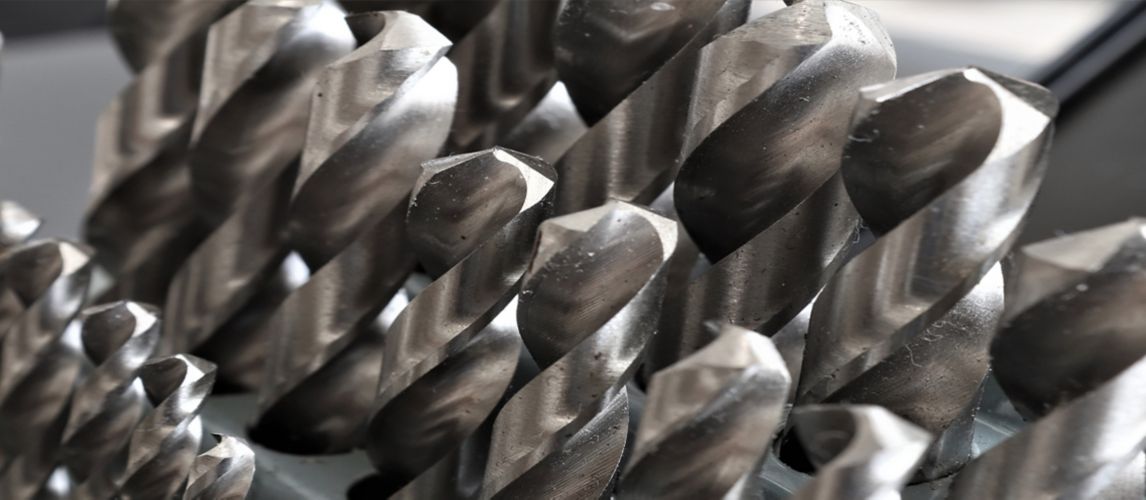
What is a Drill Bit?
A drill bit is a cutting tool that’s fitted into a power drill and used to cut holes in materials. They come in a wide variety of shapes and sizes, but they all have similar parts as follows:
- Point: the top, cone-shaped part of the drill bit that consists of a spur and cutting lip.
- Spur: this sits at the top centre of the point. It helps to get the drill bit into position.
- Cutting lip: the part of the drill bit that cuts the material.
- Flutes: a spiral channel that runs from the cutting lip to the shank. It helps to remove the material as it’s cut from the hole.
- Shank: this part of the drill bit slots into the drill’s chuck. There are several shank types which we will cover later in this drill bit guide.
The part that differs between drill bit types is usually the cutting lip. Their different designs make some more suited to cutting through certain materials than others. There are also different designs depending on the power drill they need to fit, and the type of hole being drilled.
What Drill Bit to Use?
Before buying a drill bit, it’s important to consider what you need it for. You can purchase multi-purpose drill bits, but you’ll get better results by using one specifically designed for the material and type of hole being drilled.
A drill bit's suitability for drilling into certain materials usually depends on what the drill bit is made from and coated with. The drill bit guide below describes the main options:
Drill bit materials:
- High-speed steel: made from carbon steel with chromium and vanadium additives. It’s suitable for drilling wood, plastic and soft metals.
- Cobalt: an incredibly strong alloy metal used to drill through tough materials. It can withstand heat and resistance and is the best drill bit for stainless steel.
- Carbide-tipped: one of the hardest materials on the planet, this drill bit only uses carbide on the tip. It’s suitable for drilling masonry, tiles and concrete.
- Solid carbide: a drill bit as described above, but it’s made entirely from carbide. It’s suitable for drilling into tough materials.
- Tungsten carbide: made from a mix of tungsten metal and carbon. It's even more hard-wearing than the standard carbide above. It is suitable for drilling into extremely tough materials such as masonry.
Drill bit coatings:
- Black oxide: this coating helps drill bits retain lubricants and prevent rust from forming.
- TiN: a titanium nitrate coating that slows down wear and tear on drill bits designed to cut metal.
- TiAIM: a titanium aluminium nitrate coating that increases resistance to abrasion and heat on drill bits designed to cut metal.
- SG: a silicone coating that helps a drill bit penetrate dense metals.
You may have also heard of HSS drill bits and SDS drill bits. So, let’s explain what they are:
A HSS drill bit is made from high-speed steel, as described in the materials section above. It’s often used in multi-purpose drill bits as it can be used on wood, plastic and metal. HSS drill bits are also the best drill bits for soft metals.
An SDS drill bit is a type of drill bit used in an SDS drill. SDS stands for slotted drive shaft, and it refers to how the drill bit is held in the drill's chuck. The shank of the drill bit has double grooves, which keep it extra secure and facilitates outstanding hammer action. It's made from tungsten carbide, and the drill and drill bit together make drilling holes into concrete, block and stone much easier.
Types of Drill Bit
There are many different types of drill bits available which we’ll look at in this section. In the drill bit guide below, we’ve split them into three categories: type of drilling application or material being drilled, the best types of drill bits, and then shank types.
Drill bit material guide: Drilling applications
The most important factor to consider when buying a drill bit is the type of material you’re drilling into. This will determine the type of metal and coating the drill bit is made from and the shape of the cutting lip.
Here’s a list of the best types of drill bit to use for the most popular drilling applications or material types:
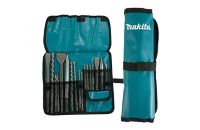
What drill bit for masonry?
A specialist masonry drill bit is the best type of drill bit to use if you’re drilling into brick, block, concrete, natural or artificial stone. They prevent the likelihood of chips and cracking and can help to reduce noise levels. They’re typically made from high-speed steel with a tungsten carbide cutting lip. They can have two, three or four cutting lips – the more cutting lips there are, the harder the material it will cut into. Most masonry drill bits can be used with a hammer action drill, but check before buying.
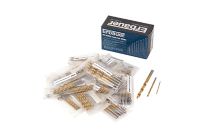
What drill bits for metal?
Specialist metal drill bits are the best drill bits for metal. However, not all metals are the same as some are harder or denser than others. So, it's important to consider what type of metal you are drilling as the drill bit must be harder than the metal it's drilling. For example, drill bits made from high-speed steel (HSS) are fine for soft metals, while cobalt is the best drill bit for stainless steel. But solid carbide or tungsten carbide drill bits are needed to cut through hard, dense metals. Also, check the drill bit's coating. A TiN coating will slow down wear and tear and increase resistance to abrasion and heat, and SG is best for penetrating dense metals.
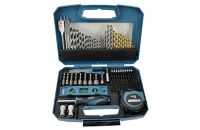
What multi-material drill bit?
If you want a drill bit that can tackle a range of materials, then a multi-material drill bit or a metal drill bit is ideal. Multi-purpose drill bits are usually made from high-speed steel (HSS) or cobalt and have a tungsten carbide tip.
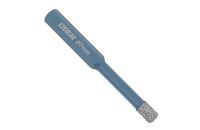
What drill bit for tiles?
To drill ceramic tiles, use a specialist tile drill bit designed to cut through class 4 tiles (tiles used in high traffic areas). These drill bits have a diamond-shaped point made from tungsten carbide that's designed to cut through the ceramic without causing the tile to chip or crack. They also have a centring tip that stops the drill bit from slipping or wandering. A masonry drill bit can also be used on tiles if used at a slow speed and without the hammer action.
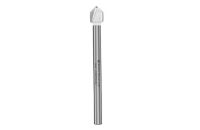
What drill bit for tile and glass?
To drill tiles and glass with a class 3 rating (used in light to moderate traffic areas), use a specialist tile and glass drill bit. These drill bits have a tungsten carbide tipped diamond-shaped point. They can withstand the high temperatures created when drilling into tile and glass.
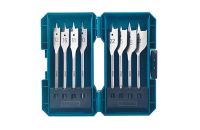
What wood drill bit types?
Most drill bits will drill through wood, but the best drill bits for wood are specialist wood drill bits. Most are made of steel, and different types of wood drill bits are available to drill different size holes. A twist bit is used to drill holes up to around 17-20mm and is better for drilling thick wood, while a flat drill bit can drill large holes from 13mm upwards in shallow wood. Some wood drills are three-point bits used in carpentry to drill small holes.
Drill bit types explained
Drill bits can also be categorised by the type of hole they cut or their usage. Each one is usually suitable for drilling into specific types of materials too. Here are the most common types:

Auger drill bits explained
Auger drill bits are designed for deep, clean drilling into thick, dry wood. They have a more pronounced central point or spur than standard wood drill bits, making it easy to locate the point that's being drilled and keep the hole on course. This type of wood drill bit is ideal for precision drilling and creating neat holes. So, this is the best wood drill bit to use if appearance is important.
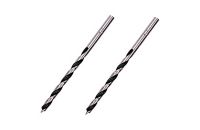
Brad point drill bits explained
Brad point drill bits are another type of wood drill bit that offers precision drilling. They have a pronounced point at the end to ensure the bit stays in the right place and extra-wide flutes that help remove the waste material quickly. They also come with rubber stoppers which allow you to set how deep you want to drill into the wood.
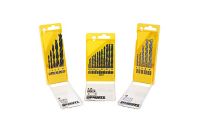
Combination drill bits explained
Combination drill bits is the term used for drill bit sets containing multiple drill bit types suitable for various materials and uses. These sets are ideal for tradespeople or DIYers who need drill bits for a range of jobs rather than someone specialising in working with specific material types.
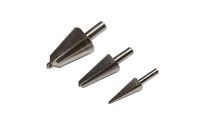
Cone drill bits explained
Cone drill bits are specialist drill bits used for drilling holes in plastic pipes and sheet metal up to 2mm thick. They are made from high-speed steel (HSS) and have a TiN coating to reduce friction. They have a cone-shaped point, making it easy to drill holes of different diameters without changing the drill bit size.

Countersink drill bits explained
Countersink drill bits are used to drill conical holes that enable flat-headed screws to sit flush against the material being worked on. Most countersink drill bits are designed to drill into wood, but some can drill into metal and minimise sharp edges. Also available are combined countersink with clearance drill bits, which allow you to drill the pilot hole and countersink in one operation.
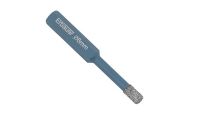
Diamond tile drill bits explained
Diamond tile drill bits are ideal for cutting through tiles and other brittle materials. They have a cylindrical shaped point made of carbide that helps to reduce the risk of the tile chipping or cracking while reducing the amount of dust produced. There are different tile drill bits designed for different types of tiles, so always check to ensure you are buying the right one for the tiles you are drilling.
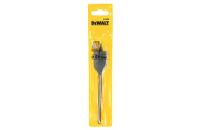
Flat drill bits explained
Flat drill bits are designed for drilling holes of 13mm or larger into shallow wood. They are also referred to as spade drill bits. They have a pronounced centre point that makes it easy to locate and drill through the centre of the hole, and the hole they produce has a flat bottom. They’re ideal for drilling large holes where the head of a screw or bolt needs to be sunk into the wood. This drill bit should always be used before drilling the pilot hole.
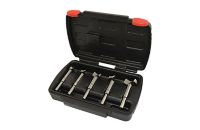
Forstner drill bits explained
Forstner drill bits are specialist drill bits used in woodworking and cabinet making. They create large, flat-bottomed holes which are required for tasks such as fitting hinges. They drill clean and smooth holes into the wood. Some have a pronounced central point for precision drilling, while others don’t.

Hinge drill bits explained
Hinge drill bits are similar to forstner drill bits as they are used to drill the holes needed to fit hinges. With these drill bits, you use the hinge as a template. The head of the drill bit sits in the space for the hole to enable you to cut the hole in the exact location.
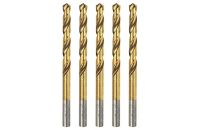
HSS drill bits explained
HSS drill bits are an acronym for high-speed steel, which these drill bits are made of. HSS drill bits are used for drilling into wood and plastic materials but are particularly good for soft metals as they are resistant to the heat generated from the fast speed operation.

Mortice drill bits explained
Mortice drill bits are specialist drill bits used in woodworking and cabinet making. They are used to cut square holes, corners or slots into wood to create mortise and tenon joints. They are used in mortising machines or drill presses rather than power drills.
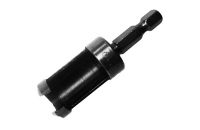
Plug cutter drill bits explained
Plug cutter drill bits are used in professional carpentry work to cut plugs or holes into wood to hide recessed fasteners. They're often used alongside countersink drill bits. They allow the screw head to be inserted below the material's surface rather than flush with it.
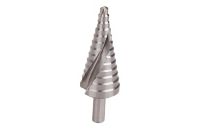
Step drill bits explained
Step drill bits have a cone-shaped point with a series of pyramid-shaped steps. They're designed to drill into sheet material and enable you to drill holes of different diameters without changing the drill bit size. In addition, some step drill bits have spiral flutes, which help remove the waste material.
Shank type explained
The shank is the part of the drill bit that’s held in the chuck of a drill. There are several types available, and you should choose the one that matches the chuck of the drill you intend to use:
-
Hex shank - A hexagonal-shaped shank used in screw guns or electric screwdrivers with a hammer mode.
-
SDS max shank - A slotted drive system shank with grooves that slot into the drill's chuck. This type of chuck is found on most hammer drills and some standard drills. It's used for heavy-duty jobs.
-
SDS plus shank - This is another type of slotted drive system. It’s used for most masonry drill bits.
-
Straight shank - A round, straight shank with no grooves or slots, used for drills with keyed or keyless chucks that hold drill bits between 10-13mm.
-
Threaded shank - A shank with a thread that screws into a hand-held drill. These drills are more compact because they don't have a chuck, so they're ideal for use in tight spaces. Other threaded shank drill bits include bits designed to be used in grinders rather than power drills.
You can purchase drill bits with these shank types in singles or packs, but drill bit sets with mixed shank types are also available.
Best Drill Bit Set Explained
Drill bits can be purchased individually as and when you need them, but drill bit sets are ideal if you want to have a variety of drill bits always at hand.
Drill bit sets are available in various combinations, including multi-purpose drill bit sets, drill bit sets for specific materials and drills, and those for specific uses. You can view our range of drill bit sets here.
Drill Bit Angles Explained
A drill bit’s angle refers to the angle between the spur and the cutting lip on its point. There are two main drill bit point angles: 118° and 135°. A drill bit with a 118° angle cuts more aggressively and is best used for cutting into soft materials such as wood. A drill bit with a 135° angle is better for drilling into harder materials such as masonry.
Metal drill bits, however, have a wider variety of point angles (90°, 120°, 135°, 140° and 145°). And the one you use should be tailored to the type of metal you plan on drilling and what the drill bit is made from. The harder the metal you're drilling into, the larger the point angle (and therefore, the flatter the point) you'll need.
What Size Drill Bit?
In addition to drill bits being available in different types, they’re also available in various sizes to allow you to drill a hole that suits your needs. The list below gives answers to the most commonly asked questions around drill bit sizes:
- What size drill bit for a wall plug?
- The drill bit size you need for a wall plug will depend on which wall plug you use. Generally, you’ll need a drill bit that’s the same diameter (in millimetres) as the wall plug, but for accuracy, you can drill a pilot hole using a slightly smaller size drill bit first.
- What size drill bit for red plugs?
- Most red wall plugs are 6mm in diameter, so to drill a hole for a red plug, you will need a 6mm drill bit.
- What size drill bit for grey wall plug?
- Grey wall plugs can vary in diameter (6-14mm). So, to drill a hole for a grey wall plug, you will need a drill bit that’s the same diameter as the plug you choose.
- What size drill bit for brown plugs?
- Most brown wall plugs are 7mm in diameter, so to drill a hole for a brown plug, you will need a 7mm drill bit.
- What size drill bit for white wall plug?
- White wall plugs can vary in diameter (6-10mm). So, to drill a hole for a white wall plug, you will need a drill bit that’s the same diameter as the plug you choose.
- What size drill bit for m10 anchor bolt?
- To drill a hole for an m10 anchor bolt, you will need a 16mm drill bit.
- What size drill bit for m8 bolt?
- To drill a hole for an m8 bolt, you will need a 14mm drill bit.
